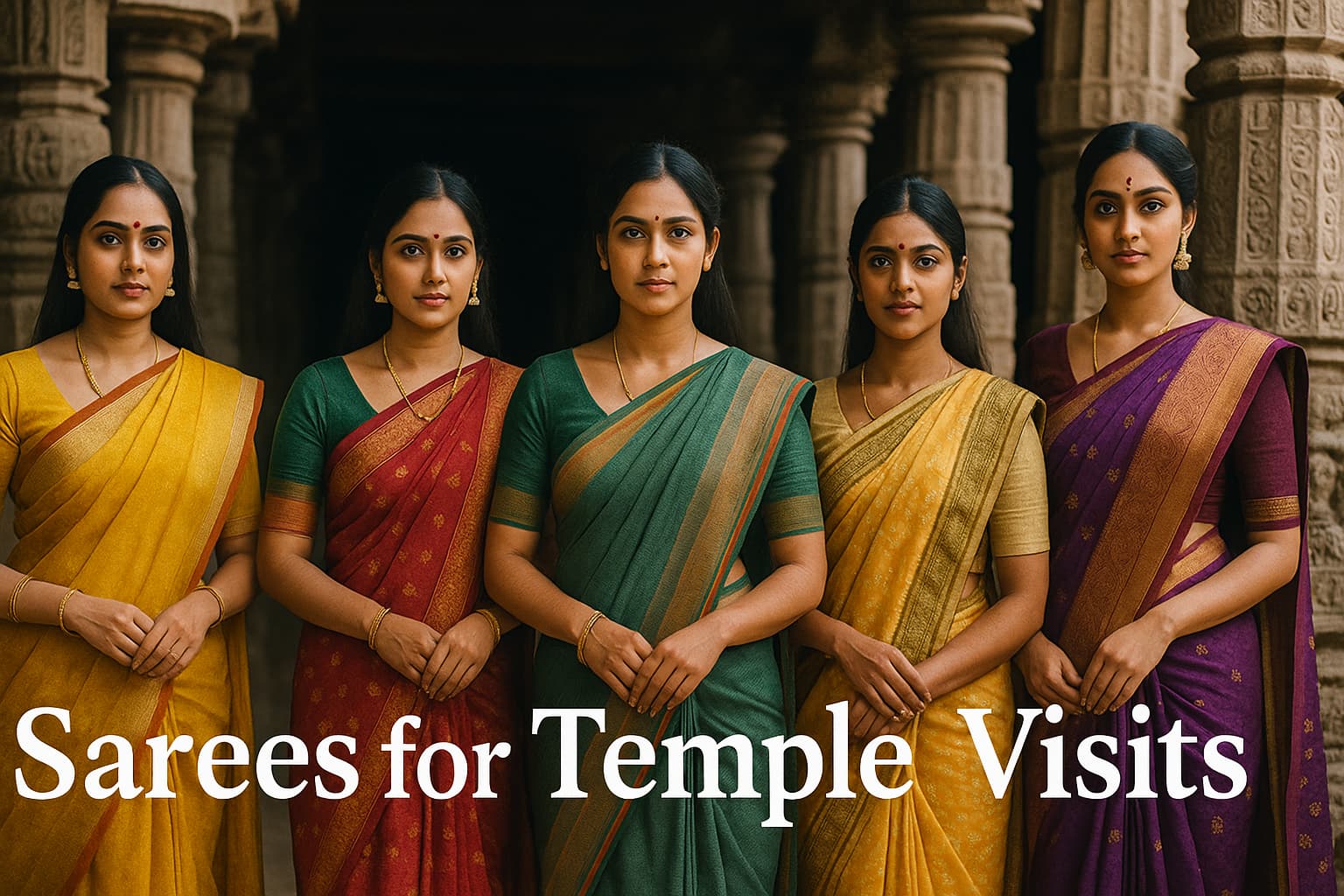Saree for temple visits isn’t just about tradition—it’s about honoring sacred spaces with grace and modesty. A temple visit is more than a ritual; it’s a spiritual journey. Just as we remove our footwear before entering, our attire reflects inner reverence. Among Indian outfits, the saree stands out as a timeless expression of respect and devotion.
But not all sarees are ideal for this sacred setting. Let’s unfold the elegance, symbolism, and styles behind choosing the right saree for temple visits.
👗 Why Saree Is the Ideal Temple Attire
The saree isn’t just an outfit—it’s a tradition wrapped in six to nine yards of fabric. For generations, women across India have worn sarees to temples because they:
- 🪔 Represent modesty and dignity
Sarees offer full coverage and graceful draping, making them ideal for sacred spaces where modesty is a sign of inner respect. - 🌿 Honor Indian cultural values
Wearing a saree reflects deep-rooted traditions passed down through generations, especially in spiritual and family-centered communities. - 🎋 Are versatile, blending tradition with personal comfort
From airy cottons to rich silks, sarees can be chosen based on the weather, occasion, and personal preference while still being culturally appropriate. - 🙏 Visually convey a sense of devotion and humility
A simply worn saree, especially in earthy or sacred colors, helps shift focus away from appearance and toward spiritual intention.
In temple-rich regions like Karnataka, Tamil Nadu, and Andhra Pradesh, the saree remains more than attire—it’s a respectful offering of presence.
👘 Different Types of Sarees Ideal for Temple Visits
Not all sarees are ideal for spiritual settings. Below are some traditional saree types that beautifully balance devotion, grace, and regional identity—perfect for temple wear.
🪡 1. Ilkal Saree (Karnataka)
Simple, rooted, and spiritually graceful
Woven in North Karnataka, Ilkal sarees feature bright borders with traditional patterns, often in red or green.
They are ideal for village temple visits, local jathres (fairs), and everyday darshan.
Ilkal sarees are comfortable to wear and reflect a strong connection to Karnataka’s heritage and humility.
✨ 2. Kanjeevaram Silk Saree (Tamil Nadu)
Elegant, grand, and auspicious for festivals
This luxurious silk saree is known for its vibrant colors, gold zari borders, and temple motifs.
It’s often worn during Navaratri, Lakshmi Puja, or Friday temple visits, especially in Devi temples.
Wearing a Kanjeevaram saree is seen as an offering of respect and festivity to the divine.
☁️ 3. Cotton Sarees (South India)
Lightweight, airy, and perfect for everyday temple visits
These sarees are breathable, easy to drape, and ideal for hot weather, especially in places like Udupi, Kolar, or Chikkamagaluru.
Simple cotton sarees are commonly worn by women during early morning darshans or daily poojas, often with minimal accessories.
They also align well with temples that enforce modest dress codes.
🧵 4. Chettinad Cotton Saree (Tamil Nadu)
Rustic charm with deep spiritual roots
Woven in muted earthy tones with traditional checks or stripes, these sarees reflect discipline and humility.
They’re ideal for quiet, early morning temple visits, especially in Shaiva or Vaishnava temples.
Chettinad sarees emphasize simplicity over sparkle, aligning beautifully with sacred rituals.
🪔 5. Banarasi Saree (North India Influence)
Rich silk elegance for special occasions
Though traditionally from the north, Banarasi sarees are now worn in southern temple weddings, vows, or special poojas.
With their brocade borders and fine detailing, these sarees pair well with temple jewelry and auspicious gatherings.
They symbolize abundance, respect, and devotion when worn in temple ceremonies.
🚫 What to Avoid While Wearing Saree to Temple
Even a traditional saree can feel out of place if styled improperly. Here’s what to be mindful of:
- Avoid see-through or netted fabrics
Transparent materials like chiffon or net may appear too revealing and disrupt the temple’s sacred atmosphere. - Don’t drape too low or too tight
Low-waist or tightly wrapped sarees look modern but lack the modesty temples often expect—opt for higher pleats and fuller coverage. - Skip heavy fashion jewelry that makes noise or distracts
Noisy bangles, anklets, or flashy accessories can disturb others and shift attention away from the spiritual setting. - Avoid wearing dark lipstick or party-style makeup
Bold makeup can appear too dramatic or celebratory—temple visits call for a calm and composed appearance.
Temples are places of surrender, not show. Keep your saree style quiet, graceful, and spiritually aligned.
🧵 Draping Styles That Reflect Devotion
The way a saree is draped can express humility, culture, and spiritual awareness. Here are some traditional styles that align with temple etiquette:
- South Indian Nivi Style
This is the most widely accepted and modest draping style—comfortable, neat, and perfect for temple visits across South India. - Madisar (Iyengar/Iyer tradition)
Worn by Brahmin women during vows or rituals, this unique 9-yard drape signifies deep spiritual discipline and tradition. - Half Saree or Davani (for young girls)
Often worn by unmarried girls, it blends cultural heritage with modesty, especially in village temples and festivals. - Pallu Over the Head
Covering the head with the pallu while entering the sanctum is a traditional sign of respect in many orthodox temples.
A saree draped with devotion is more than style—it becomes a silent prayer in motion.
🛍️ Bonus Tip: Accessories to Carry
- A small dupatta or shawl
Carrying a shawl can be helpful for covering the head or shoulders, especially in traditional temples that expect modesty. - A cloth bag (for flowers, coconut, etc.)
Temples often involve offerings—using a reusable cotton bag is respectful, eco-friendly, and keeps items organized. - No handbags or glitter clutches
Fancy purses or shiny clutches may appear flashy and distract from the serene atmosphere; keep it simple and subtle.
Choosing the right saree for a temple visit isn’t just about appearance—it’s an act of quiet devotion. For women and girls alike, wearing a saree to the temple is a way of honoring sacred space with grace, simplicity, and cultural wisdom passed through generations.
Young girls wearing a half-saree or davani reflect blossoming tradition and innocence, while women draped in cotton or silk carry the elegance of spiritual maturity. Regardless of age, the saree becomes a soft symbol of respect—where every pleat and fold mirrors discipline, humility, and inner surrender.
So the next time you prepare for darshan, don’t just reach for a beautiful saree—choose one that helps you walk into the temple with presence, poise, and peace. Let your attire become part of your prayer.
🔗 Continue Your Spiritual Journey
If you’re curious about why certain temple traditions began, explore timeless Legends from Karnataka temples.
Want to learn about the rituals these sarees are often seen in? Visit our Rituals section.
Interested in Karnataka’s own sacred weave? Read more about the heritage-rich Ilkal saree.
👗 FAQs – Choosing Sarees for Temple Visits
Cotton, silk, or handloom sarees are ideal. They are respectful, comfortable, and suited for spiritual environments.
Q2. Can I wear a transparent or net saree to the temple?
It’s better to avoid transparent, net, or overly fancy sarees. Choose modest and traditional styles instead.
Q3. What colors are suitable for temple sarees?
Light colors like white, cream, yellow, and soft pastels are considered sacred. Avoid loud or flashy patterns.
Q4. Are half sarees or lehengas allowed in temples?
Yes, young girls can wear half sarees. Lehengas are okay if they are modest and traditional.
Q5. Can I wear a saree with sleeveless blouse to a temple?
It is best to avoid sleeveless or deep-neck blouses. A dupatta or shawl can be used to cover the shoulders.
Q6. Do I need to cover my head with the saree pallu?
In some temples, yes. Covering your head with the pallu is a mark of respect, especially during aarti or darshan.

